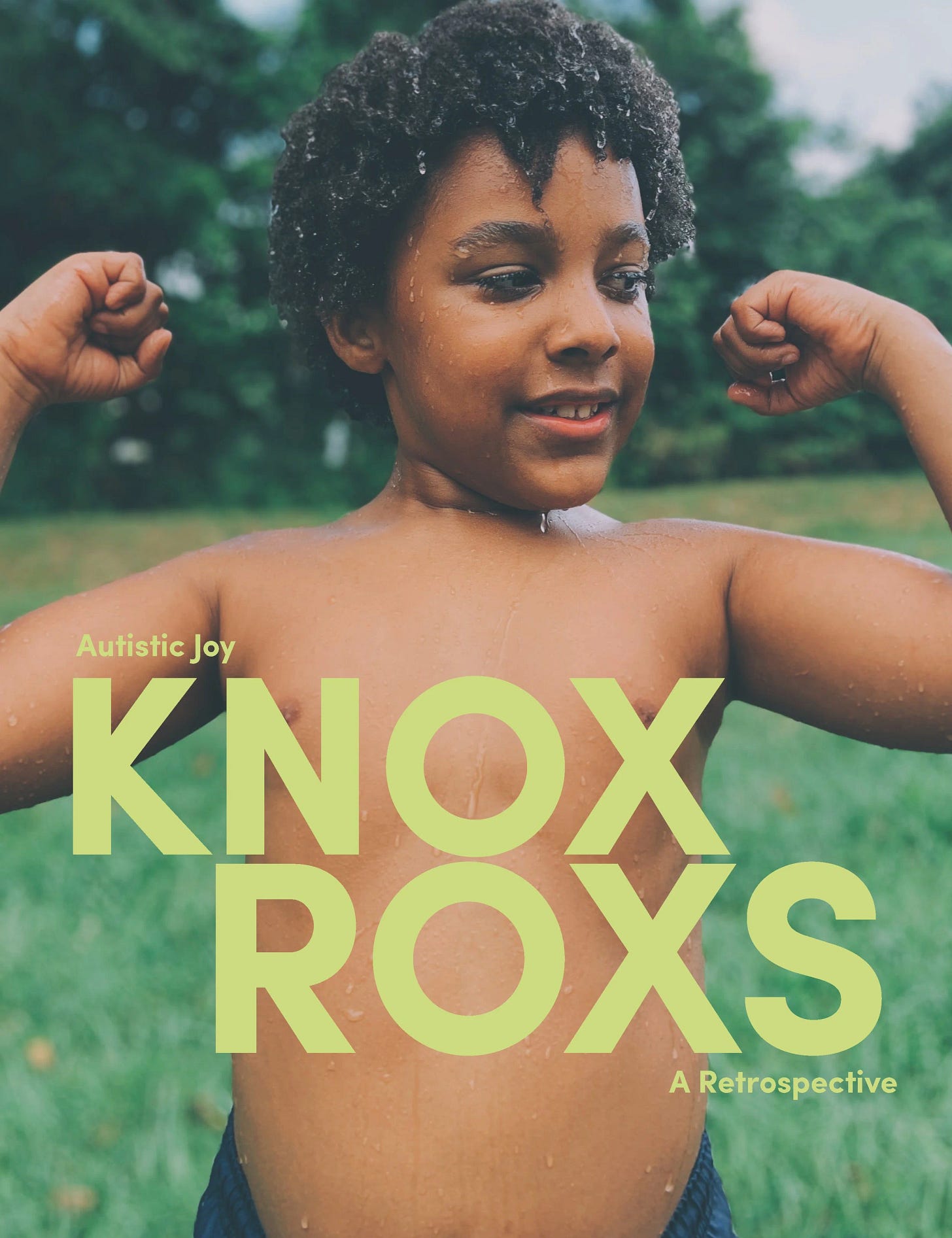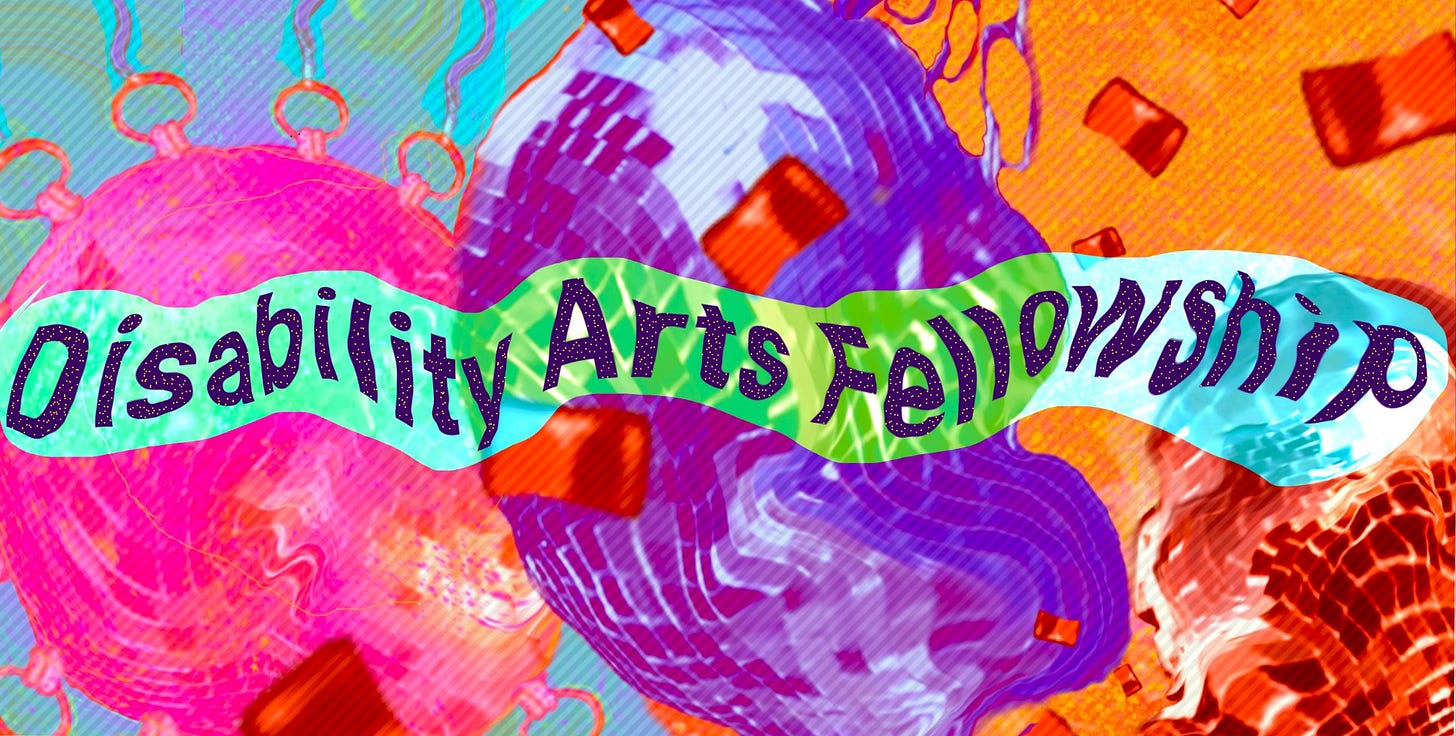Crip News v.199
Reflecting on "disability arts," new works, calls, and events.
NEWS
Whose Disability Art Worlds?
T: The New York Times Style Magazine recently published an article by arts reporter Julia Halperin about disabled artists making a “more open” art world.
When it appeared in the September 7 print issue (under the title “Open Access” starting on page 64), it was nestled among the magazine’s typical editorial and advertising spreads featuring outfits that most disabled people will never afford. In one image, the cover star, actor Riz Ahmed, wears a cardigan that costs $2,200, which is more than the total value of what any SSI recipient can own. In another image, he wears $5,600 pants.
Halperin addresses this dissonance between the fanciness of the art world and the often difficult conditions of disabled artists’ lives even as her article plays right into it. The article outlines some of the relationships between disability artistry and its changing political contexts, including pre- and post-ADA reckonings with disability as an aesthetic and identity category. “Access becomes a raw material,” Halperin concludes after talking with experts including artists Sharona Franklin, Joseph Grigely, Mark di Suvero, Jerron Herman, Emily Barker, curator Leah Lehmbeck, and art historian Amanda Cachia.
As I read the piece, I had many questions:
What are the uses of thinking about disability artistry as a singular category, identifiable over huge swaths of time?
Is this another example of the “methodological identity crisis” critic Emily Watlington identified in her review of a late 20th century survey exhibition at the Museum of Contemporary Art San Diego earlier this year?
How should we respond to incomplete citations of the origins of disability justice? What do we do with inaccurate histories about institutionalization?
Why do essays like this so often ignore the work of artists with intellectual and developmental disabilities?
High-profile analysis of disability arts, perhaps especially when written by white nondisabled journalists without previous experience writing about disability, is a good chance to better understand the field’s legibility and perceptions beyond those of us living somewhere within the proverbial landscape being surveyed.
New Works
A new report called “BSL is Not for Sale: A Deaf-led approach to AI procurement” by University of Cambridge researchers Dr. Louise Hickman, Dr. Alexa Hagerty, and Rose Powell looks at how “Sign Language AI systems are being procured across public services without adequate Deaf community involvement, creating institutional risks.”
A recent article by Michael Kimmelman and Tom Wilson in The New York Times looks at the “strange beauty” of the ramps outside NYC’s bodegas.
Universal Design and… is a new podcast hosted by activist Jos Boys that aims to “expand, stretch and challenge the concept of Universal Design.” Featuring guests Camilla Ryhl, Beata Hemer, and Helen Stratford.
Writer and artist Marisa Olson recently launched Critical Access, a project to promote access in the arts through “public programs, labs, access services, and Best Practices, our forthcoming periodical.”
KnoxRoxs: Autistic Joy is a “photozine retrospective” by
disabled artist Jen White-Johnson is on view at Julio Fine Arts Gallery (Baltimore, MD) through October 10.
Autistic researcher Hari Srinivasan recently published “The Physics of Autistic Inertia” in the Student Notebook series published by the Association for Psychological Science about how autistic people start, stop, and switch tasks.
The International Paralympic Committee recently published new research that shows that the 2024 Paris Games “triggered major changes in attitudes towards persons with disabilities and is now regarded as one of the most recognised sport events on earth.”
CALLS
Culture Push is accepting applications for the DISABILITY ARTS + DREAMING FELLOWSHIP for “self identifying disabled artists, organizers, creative thinkers, collectives, beginners, and dreamers to submit any kind of disability centered project in its very beginning stage.” Apply by Oct. 5.
The NYU Center for Disability Studies is hiring an Assistant Director. Apply by Sept. 30.
New Disabled South is hiring a Digital Fundraising Manager. Interviews begin in mid-October.
Opulent Mobility is seeking artworks for a December 2025 exhibition at the Los Angeles Makery. Submit by Sept. 15.
EVENTS
Won Lee Artists & Community Talk Series
Starting Saturday, Sept. 13, 1 - 4pm ET, on Zoom
These events are part of the Won Lee Community Arts Hub’s 2025 Summer Programs — a pilot series for Deaf and disabled, 2SLGBTQ+, and BIPOC artists.In this series, presenters share how their practice engages with community and care from a disability perspective. Together they consider disability-centred approaches to care, transforming the ways in which we live, and how art and culture align with them. Featuring Bracy Appeikumoh, Eliza Chandler, Elizabeth Mohler, Theodore Walker Robinson, Casper Sutton-Fosman, Deepikah Bhardwaj, Elizabeth Sweeney, Lilian Radovac, iowyth hezel ulthiin, Molly McGregor, Pam Patterson, Sean Lee, and facilitated by Ana Moyer.
Care at the End of the World: Dreaming of Infrastructure in Crip-of-Color Writing
Thursday, Sept. 11, 4 - 5:30pm, on Zoom
How can feminist-of-color disability politics help us navigate contemporary crises of care and decimated social safety nets? Join Sami Schalk and Jina B. Kim for a discussion of Jina’s new book, Care at the End of the World: Dreaming of Infrastructure in Crip-of-Color Writing (Duke UP, 2025), which examines the imaginative work of disabled, queer, and feminist of color literary visionaries writing after major U.S. welfare reform. Together, Schalk and Kim will foreground the necessity of a disability approach to challenging U.S. infrastructural violence and manufactured scarcity, and highlight the imaginative blueprints for survival left by radical writers of color such as Leah Lakshmi Piepzna-Samarasinha and Octavia Butler.Wheelchair Dance Skills Class
Saturday, Sept. 13, 1:30 - 2:45pm ET, on Zoom
With Travis Ammann + Marisa Hamamoto. We will guide you through basic wheelchair dance skills we’ve found useful regardless of the genre of dance. Whether you are a partner or solo dancer, a beginner or an advanced dancer, there will be something useful for you here. We understand everybody is different and every wheelchair dancer has a different chair. The goal of this intro class is to introduce you to some of our guiding principles, techniques, and mindset when approaching movement. Come with an open mind. Let’s roll.





